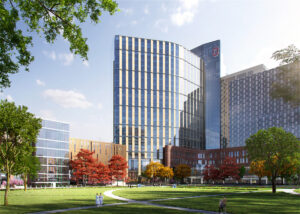Writer: Joshua Andino

2 min read December 2021— Just like the changes happening in the office world, the COVID-19 pandemic has accelerated a shift in hospital design to accommodate greater flexibility and efficiency in medicine and treatment delivery.
The changes are clearly on display at the recently-opened Hospital of the University of Pennsylvania’s new Pavilion, the largest capital project in the University of Pennsylvania’s history. The structure, the first hospital with over 1 million square feet to be awarded a LEED Gold Certification, incorporates numerous technological advances that became central to healthcare through the pandemic and that have since become mainstays of the sector, with flexibility and technology being the key components.
HDR is a member of PennFIRST, the integrated project delivery team behind the project, which includes Foster+Partners, LF Driscoll, Balfour Beatty, BR+A, and Penn Medicine, with HDR serving as the healthcare design expert. Associate Vice President and Director of Strategic Projects Daryl Bodewin told Invest: the Pavilion meets the emergent demands and expectations coming from the healthcare industry. “The Pavilion at Penn Medicine is a showcase of the clinical flexibility that hospitals strive for today. The facility features over 500 conversion-ready rooms that are fully equipped with the space, components, and infrastructure to handle any level of patient acuity, from general med/surg to intensive care. The 47 operating suites feature modular walls whose internal components can be quickly modified and adapted to accommodate changing technology with minimal downtime. The flexible planning modules utilized on the inpatient floors create a standardized but customizable layout that can easily adapt to changes in care models and clinical needs.”
The need for flexibility and technological adaptiveness, while not new trends in themselves, were greatly accelerated through the pandemic, which saw telehealth take center stage for many healthcare systems, with Penn Medicine celebrating its millionth telehealth visit since the start of COVID-19 earlier this year. Dr. William Hanson III, Penn Medicine’s Chief Medical Information Officer, said he believed that a number of visits would likely remain virtual for the convenience of patients and that the organization would continue to innovate.
 Those innovations include iPads for inpatient rooms and new occludable “smart glass” at the Pavilion. “In peak pandemic times when no visitors were allowed, we saw local institutions like Penn Medicine deploy iPads to inpatient rooms so that families could stay connected with their loved ones and communicate with their care teams,” HDR’s Interior Design Principal Sara Gally told Invest:. “We’re seeing alternative privacy methods, like switchable smart glass, that allow visibility or privacy when needed. It is more expensive than cubicle curtains on Day 1 but eliminates the operating costs of laundering and provides less risk of hospital-acquired infections from touching a contaminated curtain. The long-term benefit cost is significant.”
Those innovations include iPads for inpatient rooms and new occludable “smart glass” at the Pavilion. “In peak pandemic times when no visitors were allowed, we saw local institutions like Penn Medicine deploy iPads to inpatient rooms so that families could stay connected with their loved ones and communicate with their care teams,” HDR’s Interior Design Principal Sara Gally told Invest:. “We’re seeing alternative privacy methods, like switchable smart glass, that allow visibility or privacy when needed. It is more expensive than cubicle curtains on Day 1 but eliminates the operating costs of laundering and provides less risk of hospital-acquired infections from touching a contaminated curtain. The long-term benefit cost is significant.”
For patients at the Pavilion, the benefits include increased control over information through IRIS, a smart TV and interactive care system. “In the new Pavilion, each room is equipped with a fully integrated patient entertainment, education and communication system, which allows patients and families the ability to view the care plan, see medical information, know who is on the care team, who is entering the room and when the patient’s expected discharge date is.”
The trends are emblematic of a wider shift occurring throughout healthcare in favor of greater efficiency, maximizing space for in-patient care, and providing the most flexible workspace possible. Bodewin remarked on how those developments could be found in the new in-patient hospital currently under construction at Ohio State University’s Wexner Medical Center. “In inpatient facilities like the new tower we are designing at Ohio State University, instead of creating rooms that can flex in terms of acuity, we’re creating conversion-ready units that flex from standard to isolation, integrating the HVAC infrastructure to take an entire patient floor and convert it to negative pressure.”
A key aspect of the success HDR has found in delivering large-scale flexible healthcare projects and capital improvements has been a process called integrated project delivery (IPD). IPD “allows us to leverage the full capability of the extended team of builders, engineers, design consultants and clinicians to deliver the most efficient and innovative solutions that suit our clients’ needs,” said Bodewin, in a statement to Invest:. “This is particularly true on large-scale projects where we can really leverage the project’s size for efficiency and capitalize on the ‘blue-sky’ thinking that you never really have on smaller projects. Larger projects tend to have greater complexity and having a fully integrated team puts us in the best position to tackle complex needs head-on. This allows the project to be designed based on the construction critical path, allowing the owner more time to make responsible decisions and not be beholden to artificial project milestones.”
Gally recounted one particular example of the advantages of IPD. In the thick of the pandemic, the PennFIRST team completed specific tasks requested by Penn Medicine ahead of schedule as part of the health system’s surge planning. “The strength of our integrated project team was really tested at the beginning of the pandemic when Penn Medicine asked us to bring online 120 beds in the new Pavilion more than a year ahead of schedule in order to prepare for a surge of COVID patients,” she recalled. “Within three short weeks, our team delivered on that request, and it was because we were integrated, working in lock-step with a shared vision, culture and implicit trust from a visionary client who was embedded in the team. While thankfully, the beds were not needed, it’s a great example of the benefits of IPD.”
With the Pavilion completed and the inpatient hospital underway at OSU’s Medical Center, patients, visitors and staff will all see the very real changes underway in the healthcare sector, with greater technological capabilities and spaces designed to be flexible and adaptable, two characteristics that became key for any business during the pandemic but particularly in healthcare.
“Even before the pandemic, our clients have consistently asked us to help them provide flexibility for change in the framework of design. The needs of patient care are ever changing, and we see that now more than ever as we’ve battled the COVID-19 pandemic. Our challenge is designing spaces that are flexible enough to be tweaked and upgraded efficiently as the needs of medicine change without having to do a constant overhaul,” Gally said.

